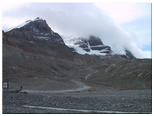









We learn about how to tie into a rope (Figure 8 knot on a bight, i.e. hairpin loop of rope), the all-important Prussik Hitch, which can be slid around on the rope but holds tight when pulled (I take a picture so I don't forget) and how to shorten a rope, i.e. coil it over your shoulder and tie it to reduce the distance between yourself and the next person on the rope.
Then we march up the glacier, roped but with no crampons. I guess the instructor wants us to get a feel for the ice first.
While all this is going on, there is a nonstop rumble of diesel engines in the background. An endless convoy of "Sno-Coaches" drives up and down the glacier, from their base on the south side, to ferry tourists to a specially graded and safety checked area out in the middle. This costs $27 a head.
A grader fixes up the Sno-Coach road every morning so that these giant six-wheel-drive all-terrain vehicles don't have to go over any bumps. All this grading eventually wears a trench into the ice. We go to practice in this trench. The Sno-Coaches have a new route further up the glacier now.
The first lesson, still with no crampons, is hacking steps into an ice slope with your ice axe, so you can get up and down it. This is rarely used in practice but could be important if, for example, a crampon breaks.
Now we get to put on the crampons. Mine are brand new. Not for long.
With crampons and ice axe, one can negotiate fairly steep ice slopes without much difficulty (although going down again is scary).
Now we are shown the crevasse rescue mechanism. The idea here is that three or more people are roped together walking along a glacier, and one of them falls into a crevasse. The others have to break his fall with their traction (it wouldn't do to have everyone pulled in). Then ice screws are put in, and a complicated network of carabiners, webbing and ropes is put together. Eventually, the rope is anchored to ice screw and backup ice screw, a 2:1 hoist mechanism is in place to pull the victim out and everything is backed up so no further accident can occur if someone trips or lets go of the rope.
However I can't believe that I'll ever manage to memorize this bewildering arrangement of equipment.
With the day's lessons done, I get a chance to photograph some crevasses as we walk down the glacier again, without ropes but with crampons this time.
The weather has really improved now. We can see all of Mt. Athabasca, the ascent of which will form day 3 of our course.
From here it looks (a) impossibly steep and (b) not really all that big. The true scale of it won't be apparent until we are up there; as line of sight goes the summit is almost 4km away from where we stand.